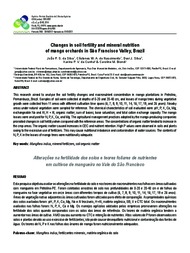Changes in soil fertility and mineral nutrition of mango orchards in São Francisco Valley, Brazil.
Changes in soil fertility and mineral nutrition of mango orchards in São Francisco Valley, Brazil.
Author(s): SILVA, J. P. S da; NASCIMENTO, C. W. A. do; SILVA, D. J.; CUNHA, K. P. V da; BIONDI, C. M.
Summary: This research aimed to analyse the soil fertility changes and macronutrient concentration in mango plantations in Petrolina, Pernambuco, Brazil. Samples of soil were collected at depths of 0-20 and 20-40 cm, and leaves of mango trees during vegetative growth were collected from 11 areas with different cultivation time spans (6, 7, 8, 9, 10, 11, 14, 16, 17, 19, and 26 years). Nearby areas under natural vegetation were sampled for reference. The chemical characteristics of soil evaluated were: pH; P, K, Ca, Mg; exchangeable Na and Al; H + Al; organic matter; sum of bases; base saturation; and total cation exchange capacity. The mango leaves were analysed for N, P, K, Ca, and Mg. The agricultural management practices adopted by the mango-producing companies promoted changes in soil fertility when compared with the reference areas. The concentrations of organic matter tended to increase in the crop areas. The organic matter caused increases in CEC and nutrient retention. High P values were observed in soils and plants owing to the excessive use of fertilizers. This may cause nutritional imbalance and contamination of water sources. The contents of N, P, K in the leaves of mango trees were nutritionally adequate
Publication year: 2014
Types of publication: Journal article
Unit: Embrapa Semi-arid Region
Observation
Some of Embrapa's publications are published as ePub files. To read them, use or download one of the following free software options to your computer or mobile device. Android: Google Play Books; IOS: iBooks; Windows and Linux: Calibre.
Access other publications
Access the Agricultural Research Database (BDPA) to consult Embrapa's full library collection and records.
Visit Embrapa Bookstore to purchase books and other publications sold by Embrapa.

